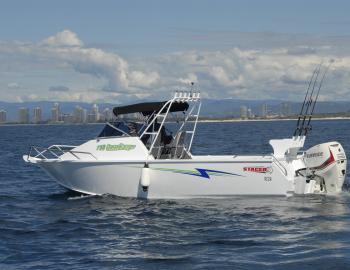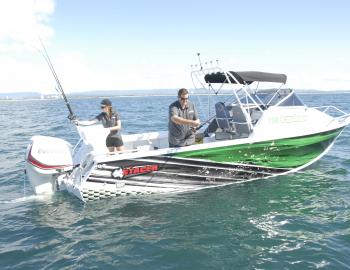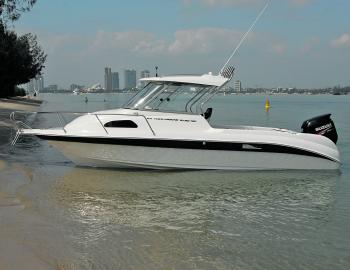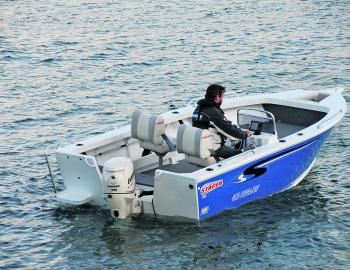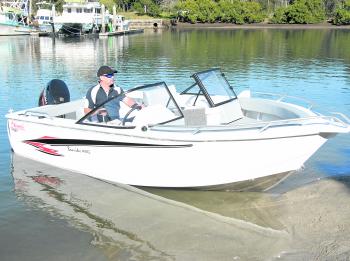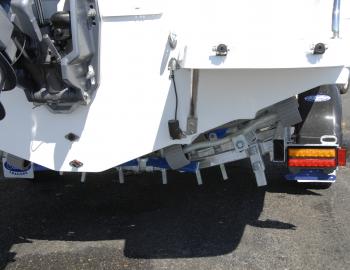The weather is warming up. Flathead, bream and tailor are on the job! The mackerel mob are going nuts in the bay and fat bass are hitting lures in the impoundments. There’s never been a better time to own a boat.
Genuine bargains are available, but you need to understand exactly what some of those entrancing, interesting and yet confusing terms mean. Here’s some insight on how to choose a rig to suit your requirements.
Outboard trailer craft come in several different styles. Open dinghy-style boats are common, steered from the rear seat via the engine’s tiller handle. Many fish are caught from small open boats, and these popular craft range from 3-5m or more in length. They can come in dinghy-style rigs to pointy punts, which offer exceptional stability. These craft are usually cheap, but come with compromises. Handy storage is more costly and weather protection is not a feature, so take the rain gear along on a fishing trip.
Runabouts are open boats with forward seating and a windscreen. These are great boats, but if the hull design is not up to scratch, the driver and passenger sit close to the bow’s impact area. This can make a rough ride. Windscreen-height seats tend to be fairly low as well, and can be uncomfortable on long runs. Weather protection will be improved with a bimini, a fabric cover or shade area set up on a metal frame.
Side console craft are open boats with a small console, windscreen and somewhere to set up navigation aids and switches set to the starboard side. These offer plenty of fishing room, but no weather protection. You’ll need a raincoat when driving into waves. This craft tends to lean if you’re alone in the rig.
The bowrider is another popular craft. It’s open, fun to be in and has great seating up front as well as astern of the mid section helm position. Great for touring, skiing and other tow sports. Bowriders are also very handy fishing rigs and often come with live wells, plush seating and a great ride.
Centre console rigs are the steering and engine controls set up on an upright centre console. These usually offer storage space and room for measuring controls. Seating is often attached, but many boaters prefer to remove the seat and stand. Centre console rigs optimise fishing space and dedicated anglers love the ride quality. A boat with centralised weight is very easily managed and rides well. Side pockets offer storage, which is always a premium in this style of open boat. An attached shaded framework to the console can offer limited protection from the harsh sun.
Centre cabin craft have oversized centre consoles and are usually over 5m in length. Ride quality and extra storage are the big attractions, and in some centre cab craft, the cabin is large enough to feature useful out of the weather seats, possibly toilets. They also provide lots of fishing room.
Half cabin boats devote around half of their space to a cabin up front. There are bunks with storage underneath, plus goodies such as interior lighting, marine toilets under a bunk or even a central in-fill, which is a cushion designed to stretch between bunks and increase bedding area. The central forward cabin hatch should provide easy anchor access at all times. Due to the weight and helm further back in the craft, ride quality is awesome with half cabin rigs. Fishing is largely confined to the rear cockpit, but weather protection is brilliant! For offshore work, these are hard to beat.
Cuddy cabs are similar to the half cabin rig, but smaller with a shorter cabin. When you look at larger cuddy cab rigs, the lines can get a bit blurry. Generally, the cuddy cab will not have sleeping bunks. Some weather protection is still featured, but the ride quality can be compromised, as the driver and first mate are further forward and closer to wave impact.
The walkaround is a feature of some half cabin craft. Walkarounds in various craft are far less likeable in bad weather. There’s walking space around the outside of the cabin, and handholds, to access the bow area. There’s usually a non-skid area to walk on and a step at the rear of the half cabin. A great addition to any walkaround is a wide forward cabin hatch near the anchor well, for when you need to access the well in unfriendly conditions.
This is the steering position. Driving a boat is often referred to as ‘helming’ it. If seated driving is the norm for your intended purchase, try sitting at the helm and check all-round visibility. Remember, dealers often adjust seating to suit a customer. In a half cabin or cuddy cabin craft, standing is an asset in times of bad visibility. A seat with a bolster front section, which drops down for extra bracing, is brilliant for standing drivers.
In smaller craft, seats can be as simple as cross members, or thwarts, which serve to brace and add rigidity to the hull, set up with flotation material. In cabin and larger craft, seats also offer height adjustment, a slide adjustable base, and a swivelling capability, which is useful for keeping an eye on trolling rods or towing water skiers. If the seating feels supportive and the helm seat provides ample legroom, with good visibility, then this one’s a go.
Most manufacturers make bigger, useful catch wells. Aeration systems are standard these days, but there’s always the option of simply loading it with ice to make a slurry and keeping the catch well chilled. At the end of the day, the well needs to be drained and cleaned or it will stink. A satisfactory drainage system won’t feed waste and debris into the boat’s under floor area – which also stinks – but will drain through a pipe. Bait wells are not standard in all craft, but are a must-have in a dedicated fishing craft. They should also be plumbed.
In smaller alloy craft, a good floor is worth considering. A floor fitted above the bottom sheeting and cross ribs of a tinny is a lot easier to fish out of a craft with a level floor. Sloping alloy sheet floors with exposed ribs tend to flex a bit when somebody is standing to fish, which means that things tend to get under those ribs. Move your feet, and the ribs quietly ease back into place, so if a sinker or swivel is trapped out of sight, there’s a starting point for havoc.
Beam refers to the width of a craft. Length is the straight-line measurement from the back of the transom, the area at the stern where the motor is usually bolted on, to the bow extremity. Overall length is measured from the transom to the end of any bowsprit or additional fitting up front, which will naturally differ from length.
Deadrise is a measurement of the angle of the vee under the hull. It starts at the bow where it’s quite sharp, then works back to a lesser angle of vee right at the transom. Some vee at the transom area can assist in a more gentle ride, but if the hull has a considerable amount of vee throughout, of a fairly light weight, there may well be leaning when the hull is at rest and passengers move to one side or the other. Such a hull is sometimes regarded as ‘tender’.
A pod is an extended area behind the transom where an outboard motor is bolted. Pods effectively extend the length of a boat’s water line and provide further buoyancy at the stern.
Strakes are longitudinal extrusions moulded or formed under the hull, to provide extra grip on the water at rest, and reduce surface tension underway by allowing some air to get in.
Freeboard measures the actual height of the sides that displaced water needs to traverse before coming into the hull. Ideally, freeboard is proportional to the craft’s length. Too little can make the ride wet and too much will mean the craft is easily blown about by wind, which makes it harder to drive.
A planing plank is a flat underwater section in the centre of the hull, which is widest at the transom. It tapers near the bow and finishes where the bow’s finer deadrise section begins. A planing plank is designed to aid stability and assist in lifting the hull out of the water into a planing situation once power is applied. This advanced design innovation is mainly seen on fibreglass craft, but some alloy craft feature it as well.
1
This set of awesome pedestal seats with strong back rests have useful lift up bolster on the skipper’s seat.
2
Prominent strakes are eye-catching on the bottom of the big Sea Fox Voyager’s hull as she jumps a wave.
3
The Procraft 6.2 has a smaller cabin, which makes it a cuddy cab. This craft features a walkaround area beside the cabin.
4
The Stacer Outlaw is a good example of a side console rig. Features include a windscreen, instruments on the console’s face as well as a top mounted sounder.
5
The Stessco Bowrider 490 offers forward and aft seating with lots of fishing room.
6
Deadrise is easily seen here, along with a central planing plank and quite prominent under hull strakes.
7
The Procraft Alloy 470 is a neat runabout craft and looks great with bimini.
8
SeaJay make a lot of useful boats. Check out their side console 520 Velocity Sports.
9
The cabin takes up half of the cabin’s length on this Stejcraft Islander 580.
10
The Stacer 739 Ocean Ranger has a smaller cabin. There are padded bunks in the cuddy cab – ideal shelter from the elements!
11
Cuddy cabs are similar to the half cabin rig with a shorter cabin. Generally, the cuddy cab will not have sleeping bunks.
Reads: 5603
